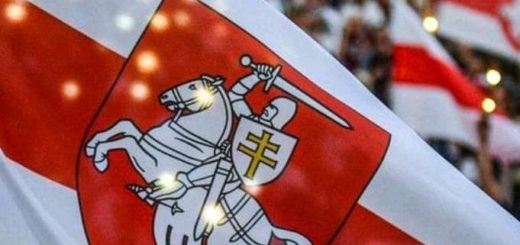The white-red-white flag of Belarus

The flag of Belarus consists of three equal horizontal stripes: white, red and white.
The flag was created in the early 20th century, however its symbolism dates back to the medieval history of the Belarusian statehood.
The colours of the flag, white and red, base on the colours of the Belarusian national coat of arms, Pahonia, as described in the 13th century Chronicle of Lithuania and Samogitia:
“в гербе муж збройный, на коню белом, в полю червоном, мечъ голый, яко бы кого гонячи держал над головою, и есть оттоля названый погоня”
(“in the coat of arms, there is an armed man on a white horse, on a red field, with his sword naked, as if he was chasing someone and holding it above his head, and thus it is called the Pursuit”)
The royal banner of the medieval Grand Duchy of Lithuania, a feudal state of which the lands of modern Belarus formed the largest part and which was shaped by Eastern Slavic culture and statehood traditions, showed the white Pahonia on a red background.
After the Grand Duchy of Lithuania and the Polish Kingdom formed a Polish-Lithuanian Commonwealth, the new state used a red-white-red banner with the royal coat of arms in the middle.
There is evidence that in the early 20th century, in the beginning of the Belarusian national revival, members of Belarusian cultural and political organisations wore red and white as their colours.
Since 1917, the white-red-white flag has been commonly used by the Belarusian national liberation movement. It was publicly displayed at the All-Belarusian Congress in December 1917, where for the first time a nationwide representative assembly called for the self-determination of Belarus. The creator of the flag’s design is believed to be Kłaŭdzi Duž-Dušeŭski, a member of the Rada of the Belarusian Democratic Republic and a well-known architect in the interwar Republic of Lithuania.
In 1918, the white-red-white flag became the official flag of the Belarusian Democratic Republic.
Between 1919 and 1939, it was used by Belarusian partisans and army units, as well as by cultural and political organisations abroad and in Poland-controlled West Belarus.
During the Second World War, the usage of this flag in Nazi-occupied Belarus was briefly allowed by the German administration.
After the war, the white-red-white flag was used as the national symbol of Belarus by Belarusian communities in the West.
On 19 September 1991, the white-red-white flag, along with the Pahonia coat of arms, became the state symbol of the restored independent Belarus. It was flown over the first Belarusian embassies opened in 1993–1995, as well as at the United Nations headquarters in New York. Under the white-red-white flag, Belarus for the first time participated as an independent nation in the Olympic Games: in Barcelona in 1992 and in Lillehammer in 1994.
In 1995, president Alaksandr Łukašenka illegally replaced the historical national flag with a slightly modified flag from the Soviet occupation era. Since then, the white-red-white flag is a symbol of the struggle of Belarusians for freedom and democracy against the regime of Łukašenka. People are persecuted by Łukašenka’s state security for publicly displaying the flag. Nevertheless, it enjoys immense popularity as the true Belarusian national symbol. Hundreds of thousands of Belarusians joined the protests against the dictatorship of Łukašenka in 2020 under the white-red-white flag.

